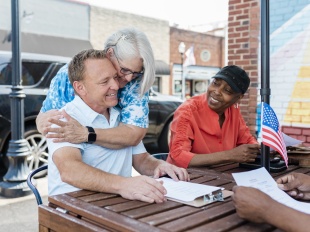Working with Community Organizers to Build Power to Improve Health
In the last few years, the state of Minnesota passed many policies that, evidence suggests, will improve health and advance health equity: an expanded child tax credit, paid family and medical leave, higher standards for workplace safety in meatpacking plants and warehouses, free school breakfasts and lunches and much, much more. It is widely recognized that community organizing groups, like ISAIAH, played a key role in making this happen.
These kinds of wins would be possible at the local and state level across the country if community organizing was stronger and if public health partnered with organizers. But what is community organizing and what does it have to do with public health?
Community organizers build power to change the rules that create our communities
For over a decade, CHR&R has made the case that if we want to improve health, especially of those in communities currently suffering the worst health outcomes, we need to improve conditions in those communities. In a recent paper and blog, we assert that we need to change the rules that create those conditions as well as who is in power to make those rules. There are written and unwritten rules – beliefs, norms, laws and institutional practices – that create, maintain or eliminate patterns of advantage and disadvantage among communities.
To improve community conditions and health outcomes, we therefore need to build the power of communities facing inequities and break the power of those working to maintain the status quo. Community organizing is an effective tool for building community power, as we’ve described in our recent podcast season, Organizing for Health.
What is community organizing?
A forthcoming paper defines community organizing as:
| “the processes by which people who have a common identity or purpose unite to build relationships, identify shared issues, collectively analyze those issues to understand structural injustices, develop collective goals based on that analysis, and implement strategies and tactics to reach those goals including: developing leadership skills, activating members for direct action and campaigning, expanding group membership, and building power among the group and broader community to influence decisions, set agendas, and shift worldviews.” |
There are many different approaches to organizing and a range of activities that can be undertaken as part of organizing. While public health employs a number of those approaches and activities, the overall orientation organizers take differentiates organizing: organizers center building power in all their work. Community organizers employ an important – and unique – set of skills in doing this.
Public health can partner with community organizers to build power, change rules and improve community conditions
There are many examples of public health agencies, non-profits and researchers partnering with organizing groups. Those partnerships have had many benefits and successes: policy wins, stronger research, increased social capital and community capacity and increased public health effectiveness. See the references below for more details.
Partnering with organizing groups also presents challenges for public health practitioners, including how we perceive our field, ourselves and our role. Are we willing to shift our mindsets away from the beliefs that public health is or must be objective and that our technical expertise alone will make change, and towards the recognition that public health must take strategic risks and conduct advocacy to truly advance equity? Are we willing to analyze the power dynamics related to the changes we want to make and use the power we have in service of communities as they fight for change? These are not the only challenges we face in this work, but they are fundamental questions we need to answer.
We at CHR&R believe that the field of public health must answer these questions and find our way toward partnering with community organizers if we truly want to advance health equity.
References
- Jimenez, C & Heller, J. (Forthcoming). Community Organizing and Public Health: A Rapid Review. BMC Public Health.
- Heller, J.C., Little, O.M., Faust, V., Tran, P., Givens, M.L., Ayers, J., & Farhang, L. Theory in Action: Public Health and Community Power Building for Health Equity. Journal of Public Health Management and Practice, 29(1). https://doi.org/10.1097/PHH.0000000000001681.
- Gaydos, M., Do-Reynoso, V., Williams, M., Davalos, H., & López, A.J. (2022) Power-Building Partnerships for Health: Lessons From Santa Barbara About Building Power to Protect Farmworker Health and Advance Health Equity. Journal of Public Health Management and Practice, 28 (4). https://doi.org/10.1097/PHH.0000000000001485.
- Subica, A.M., Grills, C.T., Villanueva, S., and Douglas, J.A. Community Organizing for Healthier Communities: Environmental and Policy Outcomes of a National Initiative. American Journal of Preventive Medicine, 51(6). https://doi.org/10.1016/j.amepre.2016.06.020.



